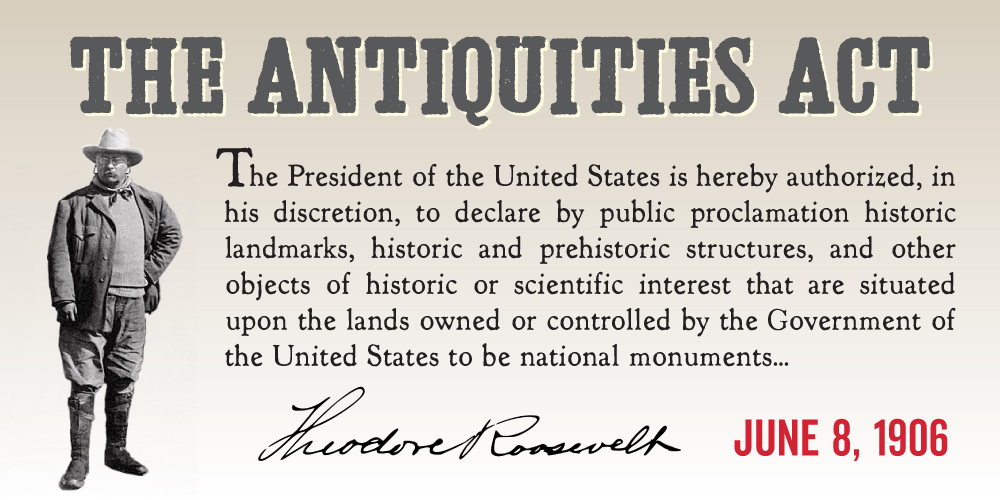What is the Antiquities Act?
Since 1906, the Antiquities Act has given the President the authority to designate National Monuments so that future generations can experience our nation’s wildlife, waters, historic sites, and open spaces.
The Act grew out of concerns that developed over the course of the last quarter of the 19th century for the preservation of America’s cultural and natural heritage. National and regional educators and scientists, including those involved in the developing profession of archeology, joined together in a movement to safeguard sites on public lands that were being disturbed and damaged by human activity.

Infographic by James Kaiser
[accordion clicktoclose=true tag=div][accordion-item title="What is a National Monument?"]
A national monument is a land, ocean, or historic area that has been given permanent protection by Congress or by the president through the use of the Antiquities Act. National monuments include key parts of our national heritage like the Canyon of the Ancients National Monument in Colorado, The Upper Missouri River Breaks National Monument in Montana, and the Statue of Liberty in New York.
[/accordion-item][/accordion] [accordion clicktoclose=true tag=div][accordion-item title="What places have been protected using the Antiquities Act?"]
A full list of protected places thanks to the Antiquities Act can be found here.
[/accordion-item][/accordion] [accordion clicktoclose=true tag=div][accordion-item title="Which Presidents have used the Antiquities Act?"]
Since President Theodore Roosevelt signed the Antiquities Act into law in 1906, 18 Presidents – 9 Republicans and 9 Democrats – have used the authority granted by the act to safeguard public lands, oceans, and historic sites in order to share America’s story with future generations.
[/accordion-item][/accordion] [accordion clicktoclose=true tag=div][accordion-item title="Who manages the national monuments?"]
National monuments can be managed by one or more of these agencies:
- The National Park Service
- The U.S. Forest Service
- The U.S. Fish and Wildlife Service
- The Bureau of Land Management
- The National Oceanic and Atmospheric Administration
- The Department of Defense
- The Department of Energy
[/accordion-item][/accordion] [accordion clicktoclose=true tag=div][accordion-item title="What can I do in a national monument?"]
You can do a lot of fun activities in national monuments. Depending on the conservation and protection needs of the area you can:
- Camp and hike
- Hunt and fish
- Ride horses
- Ride motorized vehicles on designated roads
- Bike, climb, raft, and kayak
[/accordion-item][/accordion] [accordion clicktoclose=true tag=div][accordion-item title="What kind of development is allowed in a national monument?"]
National monuments protect “existing rights.” This means that whatever you could do before it became a national monument, you can probably still do after it is designated. This includes previously-existing:
- Oil and gas leases
- Access to private property
- Valid mining claims
- Roads and utility infrastructure
- Livestock grazing
[/accordion-item][/accordion] [accordion clicktoclose=true tag=div][accordion-item title="Do national monuments help or hurt local economies?"]
The recent Headwaters Economics 2017 review confirms that all the regional economies adjacent to the studied national monuments experienced growth following a monument’s designation. National monuments help nearby communities diversify economically while increasing quality of life and recreational opportunities that make communities more attractive for new residents, businesses, and investment.
The study found no evidence that designating these national monuments prevented economic growth. Instead, trends in key economic indicators such as population, employment, personal income, and per capita income either continued or improved in each of the regions surrounding the national monuments.
[/accordion-item][/accordion] [accordion clicktoclose=true tag=div][accordion-item title="Who supports national monuments?"]
National monument designations are supported by veterans, sportsmen, Native American Tribes, local elected leaders, outdoor recreationists, local businesses and national business leaders, members of the faith community, and Americans across the country. A 2017 public comment period generated over 2.8 million comments in support of 27 national monuments designated over the past 21 years.
[/accordion-item][/accordion] [accordion clicktoclose=true tag=div][accordion-item title="Can a President reverse or reduce a monument designation made by a previous administration?"]
A recent legal analysis by the law firm Arnold Porter and Kaye Scholer found that “For over one hundred years, the Antiquities Act has allowed Presidents to create national monuments and preserve worthy lands for the enjoyment of all Americans and future generations. There are today national monuments in 31 states. For all Americans, they offer recreational opportunities and preserve a heritage of beauty, scientific marvels, and human achievement. But the Antiquities Act and subsequent legislation reserved to Congress; which has Constitutional authority over public lands, the sole power to revoke such a designation or materially to reduce the monument’s size.”
[/accordion-item][/accordion] [accordion clicktoclose=true tag=div][accordion-item title="Can people fish in marine monuments?"]
Absolutely. Like their land-based counterparts, marine monuments remain accessible to the public for purposes such as recreation and scientific research. Commercial fishing is prohibited in marine monuments, except for the Northeast Canyons and Seamounts where commercial fishermen were given seven years to adapt their business plans. The amount of fish available to commercial fishermen has not been restricted by the creation/expansion of the marine monuments, only the area in which boats can operate has been modified. We have seen no indication that it has harmed any industry profits.
[/accordion-item][/accordion]

